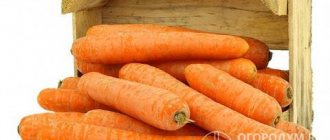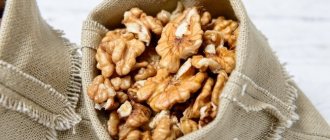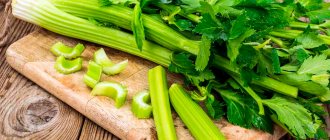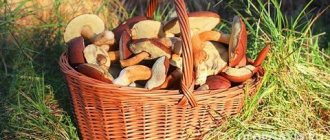The shelf life of onions largely depends on harvesting.
You should dig up onions for storage only after they are fully ripe. The main signs that it’s time are dry covering scales, a dry neck and drying leaves.
Onions should be harvested in clear, dry weather (1). The bulbs should not be pulled out - this can damage the bottom. They need to be dug up with a shovel.
Onions removed from the soil are left in the garden bed for several hours to dry along with the leaves. Then it is dried indoors for 1 – 2 weeks. After the onion dries, the roots and leaves are removed (2).
Cleaning and preparing onions for storage
You need to be able to not only grow an excellent harvest, but also preserve it until spring. Proper harvesting of bulbs from the beds will increase their shelf life. And it all starts with preparation for the collection. 20-30 days before the expected digging of the vegetable, watering is completely stopped. After 70–80% of the feathers have dried, the onion heads must be removed from the ground. By this time, the maximum amount of useful substances is concentrated in them. If you harvest too early or too late, the onions begin to rot. Signs of ripening of vegetables are the drying of the neck (the transition from the head to the feathers) and the upper layer of husk on the head.
Some gardeners set harvesting times based on the lunar calendar. Astrologers say that it is better to dig up vegetables that grow in the ground during the waning month. After all, at this time the juices of the plant rush into the vegetable. After the new moon they head to the stems. This time is not suitable for removing bulbs from the soil.
When harvesting, observe the following rules:
- Choose a dry, sunny day.
- The procedure is planned for the morning.
- If the soil is crumbly and loose, then the ripe vegetable is simply pulled out with your hands. Removal from heavy soil is done with a pitchfork or shovel. The heads are dug up and then removed by the feathers.
- The onions are cleaned from the soil by hand.
- The tops are not cut.
In the evening, the dried heads are removed from the garden bed to a permanent place for drying. This could be shelves or the floor in a shed or utility room. The bulbs are laid out on a horizontal surface in a thin layer. You can use armored mesh. This option is considered the most ideal, since air circulates not only from the top and sides, but also from the bottom of the vegetables. They dry completely.
If the harvest is small, then the onion heads can be heated in the oven. They are placed in a heated oven, then after 40-50 minutes it is turned off. These manipulations are repeated several times.
The drying process is important. Dry vegetables do not rot and therefore withstand wintering better. The drying period can be 5-8 days. When the neck of all the bulbs is completely dry, the onions are ready for storage. The roots are completely removed. If you do not plan to braid the bow, then the feathers are trimmed, leaving only 4-5 centimeters.
Only after all the manipulations is the vegetable determined for the winter.
How and when should you harvest?
It is important to harvest onions and leeks correctly and on time:
- If harvest is delayed, we experience an increase in yield causing deterioration in bulb quality, including cracking and peeling of the scales, leading to losses during storage. Larger bulbs do not dry out well enough to store.
- Before harvesting, the bulb can become infested with pathogenic fungi and bacteria, and as a result, the vegetable begins to rot.
Garlic and onions ripen in July. The optimal harvest date occurs when the plant stem falls by 3/4, and half of the leaves of the remaining plants are still green, but dry bulb scales are visible. When the stem falls to 1/3 of its height, you need to stop watering the vegetable (about 2 weeks before digging).
Do not pull the bulbs out of the ground by force; they must be dug up, otherwise injuries to the bottom are inevitable.
After harvesting, the bulbs are dried in a sunny place (usually this occurs in mid-July). Drying is carried out directly on the beds, if there is no rain, in case of rainy weather - under canopies.
In the field in the morning, the crop is covered to protect the bulbs from falling dew. Drying lasts approximately 2 weeks. Thus, the crop will dry well, the skin will harden, and acquire a characteristic color depending on the cultivated variety:
- golden,
- brown,
- Dark red.
You can't pick onions in the rain. If it starts to rain while the vegetable is drying in the garden, you must immediately move it under the roof.
General storage rules
Experienced gardeners know that there are the following rules for successfully storing any vegetables:
- availability of high-quality ventilation;
- lack of dampness and sunlight;
- creation of a certain temperature regime.
Only a combination of these factors will allow the onion heads to overwinter well.
Temperature
There are different forms of storing bulbs:
| Method name | Temperature _ | Advantages of the method |
| Cold | +3°С, 0°С | Overall yield losses are minimal. |
| Warm | +17+21° С | Suitable for indoors. |
| Combined | In autumn: +17+19° C, in winter: +2° C, 0° C, in spring - +3° C. | More economical than warm. More vegetables are preserved. |
When stored in a cellar or basement for sweet and semi-sharp varieties, the air should be no colder or warmer than + 1+2 ° C, for spicy varieties -1-3 ° C. If you do not monitor the temperature where the onions lie, this will lead to mass product damage. Frozen bulbs begin to rot, and when the temperature rises, they germinate.
Humidity
Air humidity is of great importance for the safety of the crop. Its level should not rise or fall sharply. For basements and cellars, the optimal humidity is 70-90%, for residential premises - 50-60%. If there is a lot of moisture in the air, then the vegetables begin to sprout, if there is little, they dry out.
To remove excess moisture, containers filled with wood shavings or ash or lime can be placed next to the onions.
High-quality ventilation helps maintain constant temperature and humidity levels.
sunlight
Some gardeners prefer to keep their crops on the balcony. With this storage method, it is important to ensure that direct sunlight does not fall on the bulbs. This will cause the vegetable to sprout and dry out. The container with it must be covered with thick material.
Is it possible to store on the balcony at home?
As a possible storage option, a balcony is quite suitable. It should be a glazed loggia with an opening transom. When there is no fence, precipitation gets inside and there are large temperature changes. A blind window will not allow ventilation of the room.
On a closed balcony, onions, root vegetables and pumpkins are stored in suitable containers, covered from light with burlap. If frost occurs, the temperature drops to sub-zero, supplies need to be wrapped up. The covering material can be anything: an old blanket, padded jacket, coat, batting, synthetic padding. The main thing is that the insulation layer is thick and does not allow frosty air to pass through.
Onions are frost-resistant and will not lose their qualities when the temperature drops to -3°.
How to store
There are many ways to properly store onions. The gardener independently chooses which one is best for him.
In braids
There is an old technique - braiding onions. It appeared in Russian villages and has survived to this day. It consists in the fact that the bulbs
with an uncut feather connected together, almost like a braid of hair. Such bundles can be hung in any room. In the kitchen they become part of the interior and disinfect the air. The onions are carefully trimmed as needed.
In the basket
Vegetables can be placed in wicker baskets. This container allows air to pass through perfectly and the bulbs remain fresh for a long time. It does not spoil the interior of the living space. And phytoncides destroy pathogenic microbes around.
In nylon tights
The Soviet method of storing heads in nylon stockings or tights cannot be called aesthetic. But thrifty housewives still use it. Still, it’s better if the vegetables are in a suspended state. Small holes in the fabric create the necessary ventilation.
In a box, box
Storage in wooden boxes saves space. The containers are stacked on top of each other, so you can place a large amount of crop. In addition, there is air access to the bulbs.
Cardboard boxes with small holes on the sides are also suitable for wintering vegetables. The only inconvenience is that you can’t place more than 2-3 boxes vertically.
In nets, fabric bags
Large nets are not suitable for keeping onions in them for a long time. They are suitable for transportation.
Fabric bags should be large. But they cannot be filled to more than 40% of the volume. Otherwise, the onions will begin to deteriorate en masse.
In bags, film
But plastic bags and films are completely unsuitable for storage. In them, vegetables “do not breathe”, become covered with droplets of moisture and quickly rot.
How to braid onions for storage
It is better to prepare in advance for storing onions in this way, rather than making a spontaneous decision to “braid”:
We recommend:
Storing jewelry at home so it doesn't get tangled
- Onions should be collected from the garden when the tops are not yet dry, otherwise they will crumble during the weaving process. That is, the tops should be yellow, fading, but still quite elastic. The bulbs themselves must be fully ripe, otherwise the vegetable will continue to grow and will soon dry out or begin to rot.
- The collected onions must be dried by spreading them in a thin layer on a well-absorbent material (fabric or paper).
- The braids are woven by sequentially twisting the tops of 3–5 onions among themselves, adding one at a time so that one onion comes into contact only with its neighbors below and above.
- If the tops are long, then if they are tightly woven, they will hold the bulbs well without additional fastening. If the tops are short (only 2-3 bulbs are woven), then you will have to use pieces of twine to tie the tops. Another way: insert a long twine into the braid and weave the tops with it.
Where to store
At home, onions can be stored in residential and non-residential premises. It all depends on the conditions and the amount of onions.
In the cellar, basement
Cellars or cellars have been used for wintering vegetables for many centuries. In such places, humidity and air temperature do not change sharply. They usually have enough space to accommodate a rich harvest both vertically and horizontally. Moreover, any container, any method is suitable for storage.
In the apartment
Not all people have personal plots. They try to buy more onions in the fall, when they cost less. Store the purchased product at home. In a city apartment there is enough space for this. These are storage rooms that do not have central heating radiators, so they are colder there than in other living spaces. Some housewives place containers with onions in the hallway, if their space allows. Or right in the room, next to the door to the balcony.
In a refrigerator
The refrigerator is suitable for storing leeks and green feathers. Onions will be uncomfortable there, since lower temperatures are preferable for them.
In the freezer
Some housewives prefer to chop the onions, place them in small plastic bags and place them in the freezer. Then, as needed, take out the semi-finished product and immediately use it for its intended purpose. In this case, you won’t have to constantly peel and cut onions, shedding tears. But do not forget that chopped frozen product should not be stored in the freezer for more than one month.
In the kitchen
The kitchen is a good place to store onions. But a large number of vegetables most likely will not fit there. In this place it is convenient to place vegetables woven into “braids”, placed in any container.
On the balcony
The bulbs can be placed in a loggia or on a balcony, protecting them from sunlight and sudden night frosts. If this place is well insulated, then it is recommended to leave the onions there for the whole winter.
At what temperature should it be stored in the cellar and apartment?
Most often, onions are stored either in basements or in apartments.
- In the cellar
The optimal temperature for long-term storage of onions in the cellar is about 0 degrees Celsius for semi-sweet types and about -3 for spicier ones.
The ideal humidity for this type of vegetable is about 80%.
- In the apartment
If you decide to store onions in an apartment, then choose a room for it where the temperature is about 20 degrees Celsius and the humidity is around 70%. Good ventilation is also important for the onion, otherwise it will “suffocate” and begin to rot. If the air in your home is too dry, cover the crop with prepared husks. If, on the contrary, the humidity is very high, you should add special absorbents to the containers with onions, which will absorb its excess. Typically sawdust or ash is used for these purposes.
Storage Features
The onion family is represented by many species and varieties. The housewife needs to know that each of them has storage features. How long the product will remain fresh depends on the specific conditions.
Onion sets
Sevok feels comfortable only where the temperature is about +19° C. Therefore, it should not be placed in the refrigerator, the vegetable will dry out there.
Bulb
Most often, Russian housewives grow and buy onions. After all, it comes not only in different colors, but also differs in taste. Golden, red or spicy onions stay fresh the longest if you keep them in the cellar. And in the living room you need to find a cool and ventilated place.
Whole
The container in which whole bulbs are placed must be breathable. Moreover, it is better to place different varieties separately. Small specimens should be immediately sorted and used first.
Purified
Do not forget that partially diseased bulbs can be made healthy by peeling them. Subsequently, the vegetable will be covered with it again. It is better not to leave such specimens for long-term storage. And put it in a suitable container and place it in a cool place. If possible, use vegetables quickly to prepare various dishes. If there are only a few peeled onions, they can be placed in plastic or glass containers and stored in the refrigerator.
Sliced
Sliced onions can be packed in small plastic bags and placed in the freezer.
Marinated
Onions are pickled. To do this, the bulbs are peeled, washed, chopped and placed tightly in glass jars. Add spices if desired. Then pour marinade and seal. Store the preparations in the refrigerator.
Fried
Onions fried in refined sunflower oil should be placed in a glass or plastic container and placed in the refrigerator. The shelf life of such a product is no more than 4-6 days.
Dried
If the apartment is small and there is absolutely no space to store whole bulbs, then they can be dried. To do this, use ovens, microwave ovens or electric dryers. First, the onions are peeled, thoroughly washed under running water, and cut into medium-sized pieces. Then use the desired electrical appliance:
- The baking sheet is filled with vegetables in one layer, put in the oven for 2.5-3 hours at a temperature of 50–60 °C. At the same time, make sure that the onion does not burn.
- In the microwave, place the pieces between two paper napkins and turn on the mode for a maximum of 3-4 minutes.
- The instructions for the electric dryer describe in detail the mechanism for preparing the product.
After cooling, the finished semi-finished product is placed in fabric bags or wooden containers and stored like regular spices.
Saline
For some salads, housewives use pickled onions. The recipe for its preparation is simple. Mix the chopped pieces with salt (the ingredients are taken in different proportions), put in a container, close with a lid, and put in the refrigerator. After 5-7 days the mixture is ready for use. It is better to prepare this seasoning in small portions.
White
White onions differ from regular yellow onions in their skins. It is thick, similar to wax paper. The product can be stored for no more than 4-6 months in a dry place.
Green (fresh)
Green onions can be kept fresh for a long time in several ways:
- In the refrigerator in cling film, but the feathers must be strong and without damage.
- In the freezer - sliced and packed in plastic bags.
- Salted or filled with vegetable oil - in a sealed container in the refrigerator.
Or you can put green twigs in a glass filled with clean water. But in this case, the product should be used quickly.
Leek
To preserve leeks, they resort to the following manipulations:
- remove all yellowed parts;
- shorten the roots a little;
- a small plastic container with holes at the bottom is placed in the cellar and filled with raw river sand;
- Vegetables are planted in this improvised bed.
They are then removed and prepared as needed.
If this method is not suitable, then the roots of the leek are cut, leaving no more than 1 centimeter. The bulb is then placed in a damp cloth. The entire structure is wrapped in cling film. In this state, the product will last in the refrigerator for a couple of months.
Seminal
Particularly zealous gardeners buy seed material in the fall. At this time, its cost is low. One problem arises - how to preserve the vegetable before planting. This can be done in two ways - warm and cold. According to the first, the onions are poured into shoe boxes with holes in the sides and placed in a cool, dark place in the apartment. You can also place them in fabric bags in the basement or cellar. This is the second way.
Red
Bulbs of burgundy or purple color are often called red. They differ from yellow ones in their sweeter taste and shorter shelf life. If they are placed in a basement or cellar, they will remain fresh for no more than 3-4 months.
Yalta
The Yalta variety of onions has a unique taste. But the vegetable can remain in good condition for no more than 5 months from the date of harvesting. Therefore, as soon as the age of the onions approaches this period, it is better to preserve or pickle them.
shallot
Shallots are placed in wooden boxes or nets in a layer of no more than 4 centimeters. The warm method is used (stored in a living room at a temperature of 19–20° C) or cold (in the underground, attic, where the air does not warm up above +2+5° C). In the second case, the period will be no more than a year.
Rezanets (aka skoroda)
The feathers of chives, which are also called chive and chive, look like thin tubes. They can stay fresh in the refrigerator for 5-7 days. And during freezing, they completely lose their beneficial qualities. Therefore, for longer storage, it is better to salt the feathers or fill them with vegetable oil.
Popular questions and answers
We talked about storing onions with agronomist-breeder Svetlana Mikhailova - she shared with us some tricks.
How to store onion sets?
The optimal storage temperature for onion sets is 20 – 24 °C. If it is stored at a temperature of 2 - 10 ° C, all the bulbs will go into arrows in the summer and will not produce a harvest. At 10 – 16 °C, the process of formation of arrows in the bulbs is slowed down, but there will still be a lot of them.
Why do onions rot during storage?
Onions will probably rot if stored in the refrigerator - it is too humid for them. It often rots if it begins to sprout. But most often they rot due to disease, if during growth in the garden it was affected by fusarium, bacterial or gray (neck) rot. To prevent onions from rotting, it is important to observe disease prevention measures during cultivation and storage conditions.
What types of onions are suitable for long-term storage?
We can recommend proven varieties: Bamberger, Hercules, Globus, Red Baron, Strigunovsky, Sturon, Centurion.
Sources
- Fisenko A.N., Serpukhovitina K.A., Stolyarov A.I. Garden. Directory // Rostov-on-Don, Rostov University Publishing House, 1994 – 416 p.
- Group of authors ed. Polyanskoy A.M. and Chulkova E.I. Advice for gardeners // Minsk, Urozhay, 1970 – 208 p.
- Smirnov A.V. World of plants. Stories about cultivated plants // M.: Young Guard, 1988 – 303 p.
To prevent onions from sprouting
To prevent the bulbs from germinating, you need to monitor the temperature and humidity. As soon as they begin to rise, this will be a signal for the feathers to begin to grow. And you can eliminate troubles only by arranging ventilation in the place where the vegetables are located. Constant air circulation will prevent sudden changes in temperature and humidity.
Preparation
How to prepare onions for storage? The collected bulbs are dried for two weeks , laying them out in a thin layer on a dry surface (boards, blanket, etc.) outside. In case of bad weather, dry the onions by spreading them in a thin layer in a well-ventilated area (for example, on a veranda or balcony).
Another option is to dry the onions in the oven . It is heated and turned off, when it becomes warm inside the cabinet (not hot), put onions there.
It should not be overdried , a sign of which is severely cracked scales.
The bulbs must be cleaned of excess scales and soil. After drying, the leaves are cut off, leaving 4-5 cm of the neck and roots, without causing damage to the bulb itself.
Onions are sorted , selecting the bad ones: wet, with a green neck, soft, damaged. For storage, leave the dried and dense bulbs.
are peeled as much as possible before drying . He should be almost naked. When the onions dry, scales will appear on them again.
The nuances and conditions for storing onions in this video:
Neighborhood with other products
In the cellar, containers with bulbs should be placed away from vegetables that grow in the ground. Neighborhood with dried berries, fruits, herbs, garlic is preferable.
In the refrigerator, onions should be kept packed in thick containers or cling film. Otherwise, some products may become saturated with a pungent onion smell and become unfit for consumption.
Alternative methods
Onions can be dried, pickled or pickled. This method of preparation will save space in the apartment and retain most of the nutrients in vegetables.
Dried
Onions, deprived of moisture, remain edible throughout the year. There are several ways to dry it:
In the fresh air . The pieces are laid out on a board, cardboard or cotton cloth. Drying time is about 14 days.- In an electric dryer . Depending on the thickness of the rings, drying takes from 5 to 7 hours.
- In the oven . The baking sheet must be covered with parchment. The cabinet should not heat above 60 degrees. Drying time – from 5 hours.
- In an air fryer . With its help, vegetables can be dried in an hour.
Regardless of the drying method chosen, the onions must be peeled and chopped. Store them in glass jars or paper bags.
How to dry onions in an electric dryer, video instructions:
Pickling
Traditional pickling involves using 1 kg of onion and 200 g of salt. Some housewives add vegetable oil to jars.
Procedure:
- peel, wash and cut the onion into rings;
- sterilize jars;
- Place prepared vegetables in them, sprinkle all layers with salt;
- Close the jars and put them in the pantry or refrigerator for storage.
Pickling
Pickling onions for the winter is not difficult. To prepare the brine you will need:
- 1.5 liters of water;
- 1 tbsp. l. salt and 3 tbsp. l. Sahara;
- 0.5 tsp. citric acid;
- 120 ml vinegar 6%;
- For taste, add a little dill, bay leaf, peppercorns, and cloves.
Procedure:
- Sterilize the jars and fill them with onion heads.
- Prepare the marinade by bringing it to a boil.
- Pour it into jars and leave for 20 minutes.
- Drain and boil the marinade again.
- Pour brine over the bulbs again and roll up the jars.
Onions prepared this way will be stored for about a year.
How to pickle onions for the winter, video recipe:
Why do onions rot?
Sometimes it happens that despite all the measures taken, onion heads begin to rot. And the following diseases can cause unpleasant processes:
- Bacterial. With them, rotting dark scales appear.
- Fungal. In this case, the entire bulb rots.
- Fusarium. The vegetable becomes soft and watery.
The beginning of the problem can be recognized by the appearance of a persistent onion smell. It is he who signals that the harvest needs to be sorted. Overly infected specimens should be thrown out, and in slightly spoiled specimens, the infected areas can be removed. In this case, contaminated products cannot be stored: the onions must be used immediately for cooking.
Onions are considered an agricultural crop that is unpretentious in storage. But it also requires periodic attention. Only compliance with harvesting rules, proper preparation and optimal conditions will ensure the preservation of the taste and smell of vegetables. When choosing recommendations, you need to pay attention to the individual characteristics of the variety. Sometimes the preferred storage method will depend on them.
Difficulties and ways to eliminate them
There are several reasons why onions in an apartment can spoil:
- Re-sorting of vegetables . If there are different varieties in one box, then it will not be possible to avoid rot. This is why it is so important to carefully sort through the crop immediately after harvesting.
Damage to vegetables . They must be stored carefully, avoiding injury to the heads.- Rotting of one or more specimens . If you don’t sort the bulbs at least once a month, you can lose most of the harvest.
- Removing the husks before storing . Scales should not be removed from the bulbs. They protect vegetables from spoilage.
- Root germination . To avoid this problem, you need to treat them with lime or cauterize them.
- Bulb rotting due to dampness . If the humidity level in the room is high, then next to the boxes you need to place a bucket of sawdust or wood ash.
Read more about why onions rot during storage and how to avoid it in this article.
Possible causes of onion spoilage during storage, preventive measures
Almost all reasons for onion spoilage are associated with non-compliance with temperature and humidity percentage.
Neck rot of onions
An ailment such as neck rot can develop due to the content of fungal mycelium in the soil or due to non-compliance with the correct temperature regime. The infection itself can enter the bulb at the harvest stage, especially if it was carried out in rainy weather, but it will begin to rot during storage, when the temperature is more than +24C. Externally, the bulb begins to turn black on top, softens inside, and eventually it is completely covered with a black or gray coating of mycelium. To prevent this, it is necessary to collect onions as they ripen, dry them properly and store them correctly.
Fusarium
Fusarium is another result of the influence of unfavorable weather on onion growth. Like other fungi, fusarium can infect a crop through the soil or develop in a healthy bulb. Fusarium is manifested by deformation of the onion leaf plate and the appearance of yellowness on it. The plant itself stops developing, and the bulb acquires a gray core. In addition, an infected bulb can infect all the remaining bulbs, which can lead to rotting of the entire crop even during storage. In order not to develop fusarium in your area, it is necessary to take preventive measures and avoid waterlogging.
White rot
Sclerotinia or white rot affects all parts of the plant and you can easily “pick up” this fungus. The fungus develops in warm weather and high humidity. While harvesting onions, you may notice that the tops have lost their vital energy, and the root system is covered with white secretions. The bulb itself also rots, but the peak of rotting occurs during storage. To preserve the harvest, it is necessary to immediately remove infected bulbs and use sterile instruments, carry out preventive measures and not over-moisten the soil.
Wet bacterial rot
For the death of an entire crop, one bulb sick with wet bacterial rot may be enough. When harvesting, you can notice the wilting of the tops, but on the bulbs themselves there is nothing except a light rim around the neck. In fact, the inside of the bulb begins to lose its elasticity and darken. As a result, the bulb rots and begins to emit a foul odor. During storage, bacteria from the diseased bulb move to others through the neck and damage. To prevent the development of this disease, it is necessary to adhere to the watering regime, fertilize the soil and harvest on time.











